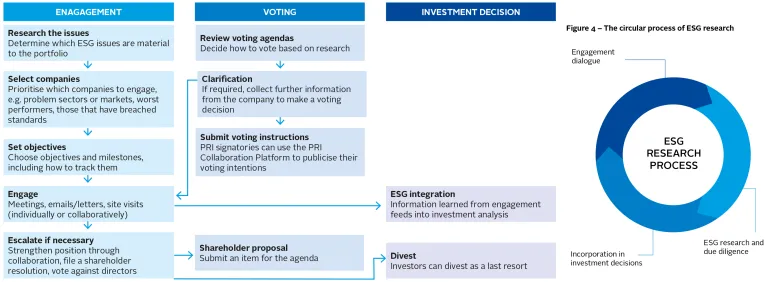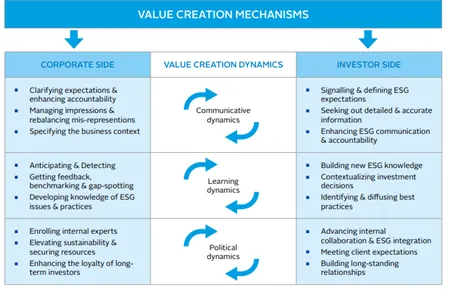The Added Value of Influencing Portfolio Companies’ ESG Practices
Since the concept of investor stewardship first emerged in the 1990’s, the idea that investment managers should take an active role in influencing the direction of a company’s environmental, social, and governance (ESG) practices has grown in acceptance and popularity. Indeed, driven by the adoption of Stewardship Codes in many geographies (e.g., the United Kingdom, Japan, and the United States), regulations such as the first European Union’s Shareholder Rights Directive (SRD 2007), and the emphasis of voluntary frameworks like the Principles for Responsible Investment (PRI), an increasing number of investors - whatever their size, investment style and asset class - are actively working toward building stewardship policies seeking to achieve improvements from the companies in which they invest in both public and private markets.
However, investment managers often struggle to build impactful and coherent stewardship strategies, prioritize and identify the right opportunities to exert leverage, and make the case for the efficacy and value of stewardship efforts to stakeholders.
Defining stewardship across investments
While different frameworks and standards define stewardship1 slightly differently, they all share a common focus: investors using their influence to increase certain investment results and returns, often with special attention paid to ESG-related outcomes. For example, the PRI defines stewardship as “investors using their influence over current or potential investees/issuers, policy makers, service providers and other stakeholders — often collaboratively — to maximize overall long-term value. This includes the value of the common economic, social, and environmental assets on which returns and clients’ and beneficiaries’ interests depend”2.
While certain investment opportunities may lend themselves more obviously to this type of direct investor influence, it is important to recognize that stewardship can be used across nearly all investment securities, with different tools available to investors3. These tactics can be undertaken in combination or in succession, individually by an asset manager directly with a company or be done in collaboration with other market players.
| Examples of ways to influence investees and issuers |
|---|
|
The belief that stewardship is important across all investment strategies and asset classes has even made its way into the PRI’s recently updated reporting framework, which applies its new “Investment and Stewardship Policy” module to all signatories.
Tips for efficient and effective stewardship practices
While the specific tactics used will vary from firm to firm, depending on investment style, sectors, and size of companies targeted, there are a few common factors necessary for investment managers wishing to engage in impactful stewardship activities:
- Clearly define what you want to achieve. Before engaging in stewardship activities, investment managers should establish specific, measurable, and outcome-oriented objectives, with clear actions focused on improving companies’ ESG performance and tailor the engagement approach to the target asset. Examples of such moves include: asking for the appointment of a director with specific skills, setting quantifiable environmental or social performance targets, adopting a specific climate change or diversity policy, or improving ESG disclosure. These goals should have a clear link to material ESG issues and focus on long-term value preservation and creation5.
- Define an escalation strategy. Clarify the approach — including appropriate trigger points and timescales — you will take if initial stewardship approaches are unsuccessful in a given time period. While recognizing that change is a process, investors should be prepared to escalate where the target of their engagement is repeatedly failing to respond meaningfully to their concerns on a specific issue. There are various tactics that can be considered, including withholding support from the board of directors or management recommendations through proxy voting or filing resolutions at AGMs, the final step being communicating the intention to divest6.
- Incorporate stewardship activities into the investment process. To be taken seriously, stewardship should not be a stand-alone activity; it needs to be embedded in the way a firm carries out its business and become a core part of the investment activity. As the PRI outlines, stewardship activities, ESG research, and investment decisions should feed into each other (see the diagrams below).

- Approach stewardship in a professional and collaborative manner. To be successful, stewardship needs to be undertaken professionally in the context of a full understanding of the companies and the drivers of their business model. It should therefore be appropriately resourced, including through collaboration with other investors. Collaborative engagement which targets groups of companies is one of the approaches that has shown the greatest potential of success7 as it increases the impact and the weight of individual investor demands on ESG issues in the eyes of corporate management and can be difficult for a company to ignore. Collaborative engagement is particularly interesting for smaller investors and for asset managers with lower levels of resources who can then share the workload and costs and build further knowledge and expertise. It is also very relevant when engaging with companies that have not been responsive to requests to engage by individual investors or when engaging on systemic and complex issues, such as climate change8. Finally, it is also one of the few ways in which shareholders and bondholders can come together on the same issues.
- Measure, assess, and report your stewardship. As stewardship activities can span several months or years, it is necessary to measure progress during and after the process. Outcome measurements related to companies’ ESG performance should be based on clear, measurable objectives set at the outset9. When outcomes are not easily quantifiable, more process-orientated and qualitative evaluation can be undertaken10.
The value of stewardship activities
Investment managers may decide to engage in stewardship activities for a variety of reasons, and stewardship activities may not always be appropriate for every firm or investment strategy. However, successful stewardship and engagement can offer benefits that investment managers should weigh against the time and resources required to complete these activities.
- Meet external stakeholders’ expectations. Policy makers, particularly in Europe, are increasingly encouraging investors to take an active role in overseeing and influencing investee companies and to be transparent about it. The European Shareholder Rights Directive II11 requests that institutional investors and asset managers develop a policy on shareholder engagement, make the policy available on their website and annually disclose how they have implemented the policy. The European regulation on sustainability‐related disclosures (SFDR) requires financial market participants to disclose ‘brief summaries of engagement policies’ as part of their entity-level website disclosures where they consider principal adverse impacts (PAIs) of investment decisions on sustainability factors. The updated UK Stewardship Code sets high stewardship standards through strong corporate governance, ESG integration, and engagement, and it requires annual reporting on signatories’ stewardship activities. In addition, PRI’s reporting on Principle 2 (active ownership) significantly weights on the scoring with 20 dedicated indicators: it assesses how stewardship is addressed by investors (policy, objectives, prioritization, collaborative engagement practices, escalation strategies), how it might differ in practice depending on asset class, and includes a section on policy maker engagement.
- Meet fiduciary responsibilities. The underlying aim of stewardship practices should always be to preserve and enhance the value of assets on behalf of beneficiaries and clients. To this end, stewardship and active engagement can be part of an investor’s fiduciary duty12. Conversely, not to use stewardship tools effectively to manage risk and maximize returns may be misaligned with the best interests of those that investment managers represent.
- Improve fund performance. It is also worth noting that a growing body of academic literature suggests that stewardship activities encouraging improved management of ESG risks and opportunities can have a positive impact on investment performance13. Stewardship may help maximize the risk-return profile of individual investments and help maximize overall portfolio performance, especially if undertaken with the aim of addressing systemic sustainability risks such as climate change. “The disruptions associated with various realizations of climate change risk will ramify across the entire economy and thus across a diversified stock portfolio. Failure to mitigate climate change risks will thus reduce risk-adjusted returns”14.
- Create value for companies and investors: Stewardship activities, and more specifically engagement, give investors an opportunity to explain their expectations in relation to managing ESG risks and opportunities, while being better informed to make investment decisions. On the other hand, companies can provide clarifications on their strategy and the relationship between ESG factors, their business model, and financial performance, while also receiving early warnings on emerging risks and best practices15.

Source: PRI How Engagement Creates Value for Investors and Companies
On the recurring question of the effectiveness of stewardship, it has been demonstrated by academic research16 that engagement focusing on outcomes is able to bring effective changes in companies’ ESG practices. For example, without years of dialogue on climate change between investors and companies, many global oil producers would have probably not considered adopting carbon-neutral strategies and improving their GHG emissions disclosure17.
Conclusion
While expectations of investor stewardship are increasing in many jurisdictions, many asset managers are in the relatively early stages of developing efficient and consistent practices and require additional time and focus on these activities.
Some investors may feel uncertain about where to begin, with the value of stewardship activities difficult to measure. Still, there are common stewardship tactics and approaches that can improve success across all asset classes.
Through steps like establishing clear stewardship goals, collaborating with other interested parties, and integrating stewardship into the broader investment process, investment managers have the potential to improve the financial performance of their investments and at the same time drive meaningful change in ESG-related matters within the investee companies. Taken together, this ultimately supports asset owners in addressing some of the world’s most pressing challenges, such as climate change risk, with their capital.
How we help
Our team of ESG experts helps firms of all sizes develop and refine comprehensive ESG programs. We work directly with portfolio companies to build industry-specific ESG programs.
Our ESG Portfolio Oversight supports the full life cycle of private market investments from diligence to on-going monitoring. We engage directly with portfolio companies to gather and report data at the pace determined by the firm, relieving much of the burden of portfolio oversight. Get timely, relevant, qualitative, and quantitative detail to tell your ESG story to stakeholders.
For questions about this article, or to find out how we can assist with your ESG data, please reach out to your ACA consultant or contact us.
Appendix
As the table below demonstrates, it is possible to exert meaningful stewardship activities in all asset classes.
| Asset classes | Examples of stewardship practices |
|---|---|
| Listed equity | As shareholders, listed equity investors can exert influence on companies, communicate their views, and input into key decisions through engagement, voting on management/shareholder resolutions and by filing resolutions themselves (in jurisdictions where this is possible). Engaging with companies (which may be done individually or collaboratively) can be done through the CEO, CFO, IR functions, or through industry bodies. |
| Fixed income | Fixed income investors, as lenders of capital, are also important stakeholders with influence over issuers and legal rights allowing them to engage with companies to manage their investment risks. Fixed income investors can therefore interact with issuers on material ESG risks, particularly at the time of initial issuance and reissuance. For corporate fixed income investors, contact with the issuer is often with the company CFO or treasurer18. |
| Private equity | Given the long hold periods and controlling interest private equity firms have over their portfolio companies, private equity firms can have a high level of influence over portfolio company management, especially if they have a seat on the board. This direct form of influence can be used to help portfolio companies improve their ESG risks and processes and adopt leading practices in various sector of a company’s business activities. |
| Private debt | Private credit investors can also use their influence as lenders of capital to manage exposures to ESG risks and/or enhance transparency of a borrower. The ability to engage borrowers will be impacted by the level of access the lender can get to senior management and the investors involved in the deal: direct loans made by a small number or just one lender allow them greater influence to engage the borrower on ESG issues. |
| Real estate | Investors can engage with the property managers, the tenants, and the local community to drive change and address potential issues like building efficiency and safety standards. |
| Infrastructure | Investors can exert influence on underlying companies or asset management through governance arrangements (e.g. board seats). |
1. Stewardship, active ownership and engagement are often referred to interchangeably. However, stewardship overtakes the others as it aims at capturing all practices used by investors to influence companies.
2. The British Financial Reporting Council, through the UK Stewardship Code, has adopted a similar definition: stewardship is “the responsible allocation, management and oversight of capital to create long-term value for clients and beneficiaries leading to sustainable benefits for the economy, the environment and society”
3. For specific examples of stewardship activities in various asset classes, please see the table in the Appendix.
4. The Investor Forum, Defining Stewardship and Engagement, white paper 2019. According to PRI, interactions that are not seeking change or an improvement in public disclosure are not considered engagement (examples: interactions with companies for data collection and/or for research purposes related to buy/ sell/ hold decisions, standard questionnaires sent to companies, attendance at company presentations, AGMs or other company meetings). Similarly, the FRC specified in its review of reporting against the Stewardship Code in 2021, that investors should distinguish between monitoring and engagement: “monitoring includes general information gathering, whereas engagement examples should focus on specific issues or objectives raised to seek change”
5. In Investing with purpose: placing stewardship at the heart of sustainable growth, the Asset Management Taskforce has published 20 recommendations aimed at increasing stewardship activities and ensuring that they are focused on delivering long-term, sustainable benefits for investors, the economy, the environment and society.
6. https://www.unpri.org/stewardship/how-to-conduct-a-collaborative-engagement/492.article.
7. https://www.unpri.org/stewardship/overview-of-collaborative-engagement-/486.article; https://www.investorforum.org.uk/wp-content/uploads/securepdfs/2019/04/Defining-Stewardship-Engagement-April-2019.pdf
8. Such as Climate Action 100+ has established a common high level agenda for company engagement to achieve clear commitments to cut emissions, improve governance and strengthen climate-related financial disclosures. Or the initiative advance on social and human rights issues
9. For example, Climate Action 100+ tracks the progress of focus companies against a number of key indicators through regular progress reporting and benchmarking
10. Examples: Is the company open to dialogue? What steps is the company willing to take? Has the company disclosed additional information?
11. SRD II, EU 2017/828 which has amended the initial directive SRD I
12. UNEP-FI & PRI, Fiduciary Duty in the 21st Century; Investor Forum, Defining Stewardship and Engagement, white paper 2019
13. https://corpgov.law.harvard.edu/2019/11/01/stewardship-the-2020-vision/#1 https://corpgov.law.harvard.edu/2019/11/01/stewardship-the-2020-vision/#2 https://ecgi.global/sites/default/files/working_papers/documents/hoepneroikonomousautnerstarkszhoufinal_0.pdf
14. Jeffrey N Gordon - Systematic Stewardship
15. How-ESG-Engagement-Creates-Value-for-investors-and-companies.pdf, PRI
16. For example, this academic paper on active ownership concludes that: “after successful engagements (particularly on environmental and social issues), firms with inferior governance subsequently improve their governance and performance. Our interpretation is that active ownership attenuates managerial myopia and hence helps to minimize intertemporal losses of profits and negative externalities”.
17. https://www.climateaction100.org/progress/successes/
18. For sovereign debt investors, the engagement process might involve meeting not only government officials, but also trade unions, employers’ associations, media representatives and supranational entities such as the IMF, the World Bank or the OECD (PRI).


